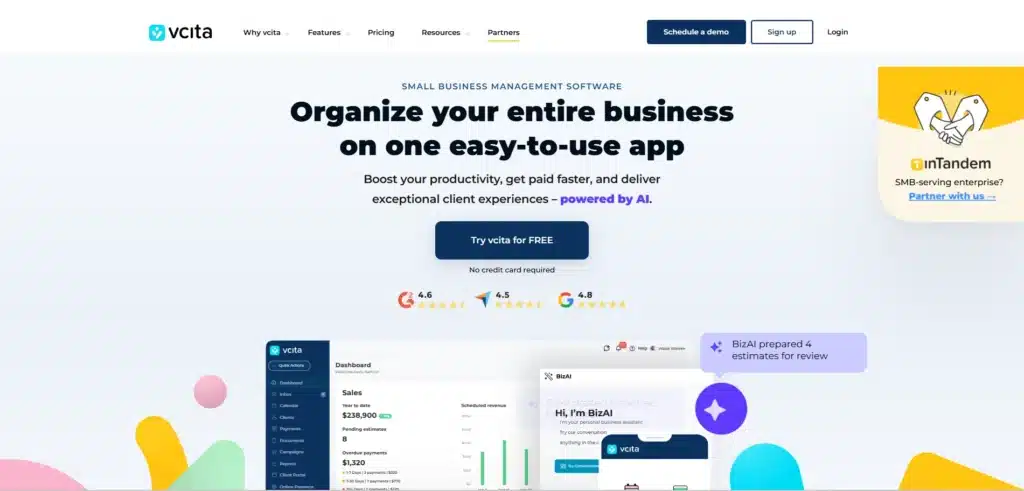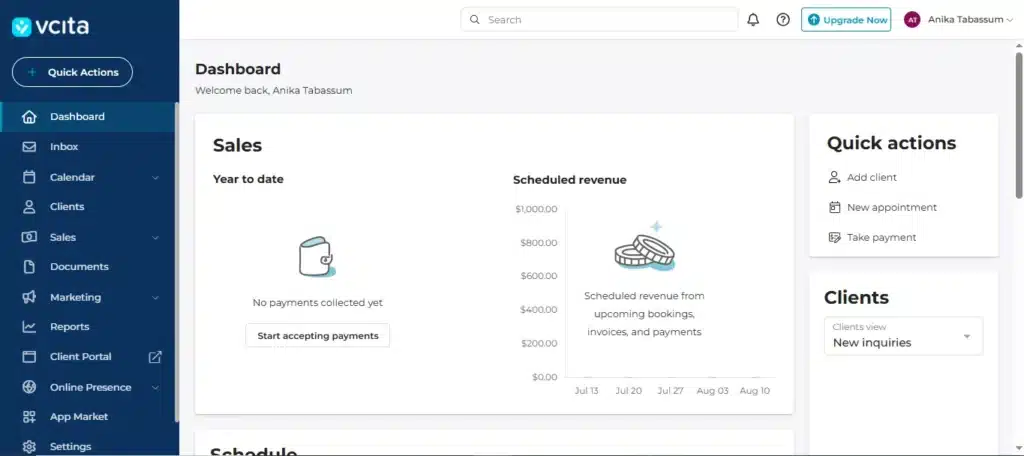As a solopreneur, I needed a system to streamline my business processes.
When a trainer trains clients one after another, managing bookings, rescheduling sessions, and chasing payments can be challenging.
I tried dozens of tools, but most were cluttered, overbuilt, or just didn’t match how I work.
So when I found vcita, it caught my attention.
It promised to be an all-in-one platform for small service businesses: client booking, scheduling, payments, and communication. It felt like vcita was built for people like me who don’t have time to “figure out” another app.
Hence, in this vcita review, I’ll show you what it’s really like to use it, how I use vcita in my daily routine, what features stand out, and whether it helped me gain peace or not.

What is vcita?
vcita is a cloud-based business management platform for small businesses and organizations. It helps you manage clients, leads, payments, scheduling, and documentation in one place.
With vcita, businesses can discover growth opportunities and extend their brand reach. The system makes it easy to deliver personalized services and attract more clients.
How did I learn about vcita?
I came across vcita during one of those late-night searches. At that time, I had just lost another lead because of a missed email.
As someone running a small business on my own, the idea of simplifying lead campaigns, meeting scheduling, and payment processing immediately got me hooked.
I had tried a couple of alternatives before landing on vcita, for example:
- Calendly was great for scheduling, but didn’t offer much beyond that.
- Square, which helped with payments but lacked deeper client management features.
Both were useful, but didn’t connect all the dots. I kept bouncing between apps and wasting time. vcita promised to fix that.
So I gave it a shot!
How I Set Up My vcita Account
Setting up vcita was way easier than I expected. I created an account, filled in my business info, and added my services in a few minutes.
To begin, I added my business details: name, email, phone, and logo. Then I added my list of services.
I introduced virtual and face-to-face classes, selected the duration of each, and set the prices. I also built in buffer time between my appointments, which kept me on schedule and not in a hurry.
Setting my availability was quick, too. I blocked the holidays and personal days so that clients could not make a reservation when I was away.
Next, I installed the vcita plugin to add a widget that helps with my bookings on my WordPress webpage.
To save my time, I had my login page automatically jump to my calendar. In that way, I could see my full schedule once I logged in each time.
I have also linked my vcita to my email and SMS tools via Zapier. In this way, I can send reminders without any additional activities.
The client portal was another great tool. Clients could log in anytime to see their appointments, pay invoices, and message me directly.
Since I work with an assistant, I added her as a staff user. I gave her access to manage bookings but limited her permissions for privacy.

Key Features of vcita
Here are the key features of vcita that help small businesses manage their operations efficiently:
CRM and Client Communication
One of the best parts is the client communication. Your clients can log in anytime to see their appointments, pay bills, or access important documents. Scheduling appointments is simple with the online booking feature.
Clients pick their time slots based on your calendar, cutting down on phone tags and missed calls.
Use email or SMS to keep freelance clients informed about promotions and remind them about future appointments. It’s a wonderful method to talk to others without overwhelming them.
vcita provides secure file sharing, so you and your clients do not have to worry about documents being stolen or disappearing in an email. Clients have the option to communicate with you instantly using SMS, which is better and faster than using email.
What impressed me was the AI-powered communication tool. It can answer common client questions for you, which saves time and keeps replies consistent.
On the CRM side, vcita does more than just store client info. You can capture leads straight from your website and track them easily. It also tracks client status so you know where they are in your sales process.

Scheduling and Appointments
Once you set up your services, booking becomes smooth. Each service has its own time, price, and location.
The calendar is easy to use. You just click “Schedule New” or choose an open time slot. Then select the client, service, and any notes.
Recurring appointments are another helpful feature. I work with several clients weekly, and setting repeat sessions saves us both time.
vcita also manages your availability. You can block off hours, choose workdays, or add breaks in between. I change mine every few weeks depending on my workload.
What I like is how vcita keeps all client info in one place. You can see past bookings, notes, and contact details with a click. Before each appointment, vcita sends automatic reminders.
Billing, Payments, and Invoicing
To start, vcita lets you create professional estimates easily. Once clients approve an estimate, you can turn it into an invoice with just a few clicks.
The AI-powered estimate feature is especially helpful for generating quotes fast based on client messages, speeding up your response time. Next, sending payment links makes it simple for clients to pay online.
You can share these links via email or other channels, giving customers a convenient way to complete payments without hassle.
Supporting multiple payment options like credit cards and Apple Pay leads to faster payments and fewer delays.
There are automated billing tools included in vcita to help save time. It is possible to schedule invoices and reminders so that you always stay up-to-date with your payments.
You can easily handle your finances using the report and analytics tools in vcita. They allow businesses to see if payments are due, what their current cash flow looks like, and which invoices have not been paid.
On the whole, vcita streamlines bills, decreases errors, and accelerates the payment process for businesses. If businesses wish to simplify invoicing and improve how they interact with customers, they can use vcita.
Client Portal
It took me under ten minutes to set up the client portal. Trust me when I say no coding is needed to set this up!
I added my logo, picked a color, and invited clients. It looked clean and professional right away.
Now, clients book, pay, and message me online. I don’t have to answer the same calls every day. It saves me so much admin time. It helps me focus on work, not chasing payments or appointment changes.
The portal runs 24/7, even at night. So, clients can schedule, upload documents, or send a quick message. Everything’s secure because vcita sends a one-time login code to make sure client info stays safe and private.
I also like how it matches my brand. It feels like a real part of my business, not a plugin. Moreover, clients can do everything from one place. It’s easy for them, and less hassle for me.
App Integration
When I first started using vcita, I didn’t expect the integrations to matter that much. I was wrong.
I connected QuickBooks first. Since then, I haven’t touched an invoice manually.
Then came Google Analytics. I wasn’t tracking much before, but now I can see where clients click, where they stop.
Zapier was a pleasant surprise. I linked it with Mailchimp and Google Sheets.
Another day, a client booked straight from Google Maps. I didn’t even know I had that turned on. It just worked.
I added Stripe and PayPal, too. Clients started paying faster. I didn’t need to remind them.
Syncing my calendar was next. I use Google Calendar, and now I don’t miss things. Later, I added Zoom.
That’s how vcita’s app integration made everything simpler.
Price vs. Value: Is It Worth Your Money?
When I first found vcita, the price didn’t seem bad. It starts at $29/month if you pay yearly, or $35/month if you pay monthly. That’s for just one user, which was fine for me when I was working alone.
As my business grew, I needed more. I upgraded to the Business plan, which was $54/month on a monthly bill or $65 if billed yearly. Later on, I even tried the Platinum plan, which jumped to $93/month billed annually or $110/month billed monthly.
So in total, I paid between $30 and $70 each month, depending on the plan I was on.
At first, I wasn’t sure if the price made sense. But once I started using all the features: CRM, online scheduling, invoicing, and email marketing, I started seeing real value.
I noticed I was spending less time managing client info and more time working. The scheduling tool alone saved me hours every week. I also loved how the CRM kept track of notes, past sessions, and payments.
Now, here’s the thing. If you only need one or two of these features, vcita probably isn’t for you. There are cheaper tools out there, some are even free.
For example, if you only need scheduling, you can use Calendly. If you only need invoices, Wave is free. But you’ll miss the smooth connection between tools.
That’s what I ended up paying for: convenience and simplicity. I didn’t have to integrate tools or deal with app limits. Everything just worked. And it worked well.
Still, I don’t think it’s for everyone. If you’re just starting out or on a tight budget, you can find cheaper ways to manage your business. But once you get a steady flow of clients, vcita can help you grow.
Tips for New vcita Users
If you are a beginner to using vcita, these tips will be helpful for you:
Start by importing your contacts:
vcita runs on client data, so your tools won’t work well without it. A full contact list helps you use features like messaging, invoicing, and appointments right away.
Set up payments and calendar sync early:
Connecting Stripe or PayPal and syncing your calendar saves time later. It also helps avoid missed bookings and makes the client experience smoother from the start.
Use the Client Portal to your advantage:
It adds professionalism and gives clients control over their bookings, payments, and messages. Make sure it’s branded and easy to access.
Don’t wait for leads to convert:
Use vcita’s forms and automation tools to follow up fast. Quick replies often make the difference between a sale and a lost lead.
Explore new features regularly:
Tools like auto-reminders, surveys, and booking restrictions can help. Testing what works best has boosted my bookings over time.
Pros and Cons of vcita
Pros:
- Combining planning and scheduling, CRM, invoicing, and payments in one easy platform
- User-friendly interface with simple setup and navigation
- Reduces no-shows using automated SMS and email reminders
- Accepts payments directly through booking links
- Good value for solo providers managing multiple tasks alone
Cons:
- Customer support can be slow and unresponsive at times
- Pricing may feel high if you’re not using all the features
What Others Are Saying About vcita
Based on reviews from TrustPilot, Capterra, and GetApp, vcita scores well for ease of use and excellent automation features.
Many highlight vcita’s wide range of features. Scheduling, appointment reminders, online payments, and email marketing are all included, making it easier to handle many tasks in one place.
From Trustpilot, we see this review:
“vcita is a one-stop solution for client management. I love its easy scheduling, smart contact searches, and automatic invoicing with low fees.”
Users also like how well vcita integrates with their websites, giving a professional look without extra hassle. The client management tools and smooth scheduling system are often mentioned as major time-savers.
However, from Capterra, we can see people complaining about their lack of customer service. Some negative reviews focus on pricing, which say it feels high for smaller businesses. There are also complaints about integration problems.
From what I’ve seen, most users have a good overall experience with vcita. The platform’s strengths in ease of use and automation tend to outweigh the drawbacks.
But inconsistent support and occasional bugs do affect some users’ satisfaction. Improving these areas could make vcita even better and help turn more users into loyal fans, in my opinion.
So, Should You Use vcita?
vcita offers great value for many small to medium-sized businesses looking for an all-in-one solution. If you need to manage appointments, clients, marketing, and payments in one place, it may be a good option for you.
vcita is an excellent fit for businesses that:
- Need a simple all-in-one platform: It combines scheduling, CRM, marketing, and payments, saving time and effort.
- Want easy appointment booking: Clients can book anytime, reducing calls and emails.
- Seek better client management: The CRM tracks interactions and builds stronger relationships.
- Want to improve marketing: Tools like email campaigns and lead generation help grow your audience.
- Value mobile access: The app lets you manage your business on the go.
You can try vcita to simplify your daily tasks and centralize your business management.
Bottom Line
For solo service providers, vcita removes a lot of stress and busywork. If your business relies on appointments and you want fewer tools to manage, vcita could be worth it.
Keep the conversation going...
Over 10,000 of us are having daily conversations over in our free Facebook group and we'd love to see you there. Join us!



